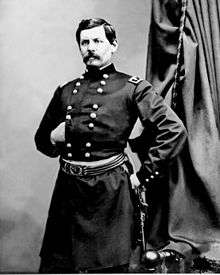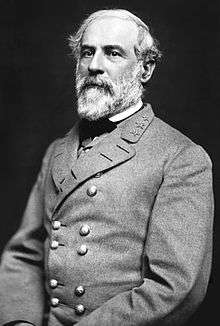Western Virginia campaign
The western Virginia campaign, also known as operations in western Virginia or the Rich Mountain campaign, occurred from May to December 1861 during the American Civil War.[1] Union forces under Major General George B. McClellan invaded the western portion of Virginia to prevent Confederate occupation; this area later became the state of West Virginia. Unionist West Virginians would fight in the campaign while also voting to elect a new governor–Francis H. Pierpont–and ratify a new abolitionist state constitution as part of the 1861 Wheeling Convention. Although Confederate forces would make several raids into the area throughout the remainder of the war, they would be unable to reoccupy the state.
| Western Virginia campaign | |||||||
|---|---|---|---|---|---|---|---|
| Part of the American Civil War | |||||||
| |||||||
| Belligerents | |||||||
|
|
| ||||||
| Commanders and leaders | |||||||
|
George B. McClellan Thomas M. Harris Isaac Duval William S. Rosecrans |
Robert E. Lee Robert S. Garnett † | ||||||
Western Virginia was an important source of minerals the Confederates needed for the production of arms and ammunition. It also contained several roads and turnpikes which would grant the Union access to Tennessee, North Carolina, and the Shenandoah Valley, while the Baltimore and Ohio Railroad in the northern part of the area connected the eastern Union states to the Midwest.[2]
Background

In April 1861 a Virginia state convention voted to secede and join the Confederacy. However, there was much opposition to this action from the western counties of the state, which were tied closer to western Pennsylvania and Ohio than to eastern Virginia. Following the secession vote in Richmond, John Carlile, a Unionist leader from northwest Virginia, led a meeting at Clarksburg which called for a convention to meet at Wheeling the next month for determining what steps "the people of Northwest Virginia should take in the present emergency."[3] The 1st and 2nd West Virginia were also raised the same month as Union infantry, participating in the first battle of the campaign at Philippi. To organize Union forces in the area, George B. McClellan was appointed commander of the Department of the Ohio, covering Ohio, Indiana, Illinois, western Pennsylvania, and western Virginia. He gathered several regiments raised in Ohio, Indiana, and western Virginia and moved into Virginia in early May, moving along the Baltimore and Ohio Railroad and the Kanawha River.[4] West Virginia, both before and after it was granted statehood, raised several infantry, cavalry and artillery regiments throughout the war to fight on the side of the Union.
The Confederates appointed several commanders to organize troops in western Virginia: Colonel George A. Porterfield in northwestern Virginia, and Brigadier Generals John B. Floyd and Henry A. Wise in the Kanawha Valley. This divided command structure prevented the Confederates from coordinating their response to the Union invasion; in addition, General Robert E. Lee, commander of the Virginia militia forces, underestimated the strength of Unionist support in western Virginia.[5]
Battles
Philippi
Confederate Colonel Porterfield concentrated a force of 775 new recruits at the town of Philippi during the month of May. On June 3, a Union column under the command of Brigadier General Thomas A. Morris launched a two pronged attack on the Confederate camp. The Confederates fired a single volley and then retreated from the town. Only a few were wounded on each side.[6]
Rich Mountain and Laurel Hill
Confederate Brigadier General Robert S. Garnett concentrated a small force around Laurel Hill and Rich Mountain. McClellan detached a small force which outflanked and routed the Confederate left wing on Rich Mountain, which left the main Confederate force at Laurel Mountain isolated and forced Garnett to retreat.[7]
Corrick's Ford
During the Confederate retreat from Rich Mountain, Garnett deployed a small force of skirmishers at a ford at the Cheat River in order to delay the Union pursuit. However, Garnett was killed by a Union volley, thus becoming the first general officer of either army to die in the war. The Confederate force was routed.[8]
Kessler's Cross Lanes
The Confederate brigade of Floyd attacked a Union regiment under Colonel Erastus Tyler at Kessler's Cross Lanes and routed it, temporarily securing the eastern Kanawha Valley for the Confederates.[9]
Carnifex Ferry
Brigadier General William S. Rosecrans took three brigades from Clarksburg and attacked Floyd's brigade at Carnifex Ferry. Although the Confederates were able to hold off the Union attacks, they were outnumbered and were forced to retreat that night.[10]
Cheat Mountain
During the summer, the Union army concentrated their forces to protect the main highways through western Virginia. Brigadier General Joseph J. Reynolds commanded the Union garrison on Cheat Mountain that was supposed to protect the Staunton and Parkersburg Turnpike. Lee attempted to drive this force off the mountain with a complicated plan involving several columns which would converge on and surround the garrison. However, one of the brigade commanders who was scheduled to start the attack retreated at the last minute, forcing Lee to cancel the offensive.[11]
Greenbrier River
Union Brigadier General Reynolds attacked the camps of Henry R. Jackson's brigade but was repulsed. Following an artillery bombardment, Reynolds withdrew back to Cheat Mountain.[12]
Camp Allegheny
Union Brigadier General Robert H. Milroy attacked Camp Allegheny, where Colonel Edward Johnson's main Confederate force in western Virginia was located. The Federal soldiers were repulsed.[13]
Aftermath

The Union army would occupy the western region of Virginia for the rest of the war, despite several raids by the Confederates into the area. West Virginia would later be split from the Department of the Ohio and be formed into a new Department of Western Virginia.[14] The Wheeling convention quickly organized the Restored Government of Virginia. This Unionist government claimed to be the legitimate government for the whole of Virginia with Richmond as its capital, although its de facto control was limited to those parts of the state held under federal arms. This arrangement would last until 1863 when western Virginia was admitted to the Union as the state of West Virginia.[15] Following West Virginian statehood, the Restored Government re-located to Alexandria where it remained for the duration of the war.
Due to his victories in western Virginia, McClellan's reputation quickly grew in the North, where the newspapers called him the "Young Napoleon." Following the Union defeat at the First Battle of Bull Run, he was given command of the Army of the Potomac.[16] Lee was much criticized in the press because of his defeat in western Virginia. Called by the press and the soldiers "Granny Lee" and "Evacuating Lee", he was transferred to South Carolina to supervise construction of coastal fortifications. The remaining forces in western Virginia were organized into the Army of the Northwest until it was incorporated into the Valley District of the Army of Northern Virginia.[17]
Notes
- "Civil War Battle Summaries by Campaign". Civil War Sites Advisory Commission, American Battlefield Protection Program, National Park Service. Retrieved 7 May 2012.
- Boeche, p. 33; Newell, pp. 29–31, 33.
- Newell, p. 16.
- Newell, p. 59-60.
- Newell, p. 50, 75, 146.
- Kennedy, p. 6
- Gallagher, p. 7-8
- Newell, pp. 138–140.
- Kennedy, p. 9
- Kennedy, p. 9
- Kennedy, p. 10
- Kennedy, p. 10
- Kennedy, p. 10
- Newell, p. 256.
- Newell, p. 269.
- Newell, pp. 164, 170; Boeche, p. 31.
- Cochran, pp. 35–36.
Sources
- Boeche, Thomas L. "McClellan's First Campaign." America's Civil War, January 1998.
- Cochran, Darrell. "Granny Lee's Inauspicious Debut." America's Civil War, September 1994.
- Gallagher, Gary W. "Rich Mountain, West Virginia (WV003), Randolph County, July 11, 1861." from The Civil War Battlefield Guide, 2nd Edition, edited by Frances H. Kennedy. New York: Houghton Mifflin, 1998
- Kennedy, Frances H. The Civil War Battlefield Guide, 2nd Edition. New York: Houghton Mifflin, 1998
- Newell, Clayton R. Lee Vs. McClellan: The First Campaign. Washington, D.C.: Regnary Publishing Inc., 1996. ISBN 0-89526-452-8
- Mallinson, David "Confused First Fight." America's Civil War, January 1992.